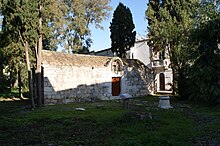Panagia Gorgoepikoos (Kos)
The church Panagia Gorgoepikoos ( Greek Ιερόϛ Ναόϛ Παναγίαϛ Γοργοεπήκοος ; oe and oo pronounced separately: Gorgo-epíko-os ) is located in the town of Kos on the Greek island of Kos . The church was dedicated to the quickly listening ( Greek Γοργοεπήκοος Gorgoepíkoos ) Mother of God .
The church belongs to the Orthodox Metropolitan of Kos and Nisyros , which in turn reports directly to the Ecumenical Patriarchate of Constantinople Opel ( Greek Οικουμενικό Πατριαρχείο Κωνσταντινουπόλεως Oikoumenikó Patriarcheío Konstantinoupoleos , Turkish İstanbul Rum Ortodoks Patrikhanesi , even Church of Constantinople Opel ) is a subordinate.
location
Today the church is on the edge of the Agora (Chora) archaeological site , about 4 meters above sea level. The sea is about 90 meters in a straight line to the northeast, the port of Kos about 230 meters northwest. To the northwestern Platia Platanou with the plane tree of Hippocrates , the Gazi Hasan Pasha Mosque , the Governor's Palace of Kos and the Hamam of Kos it is about 100 meters as the crow flies. The Neratzia fortress is located behind the Platia Platanou about 180 meters away.
History and buildings
The church is located on the edge of what was later named the Agora (Chora) excavation site, which was originally the walled medieval city of Kos and was destroyed in an earthquake in 1933. The church dates from the late Byzantine period (early 15th century). In the vicinity of this cemetery chapel is the church of St. George Arrenagogeiou from the same period.
The single-nave church building was built as a cemetery chapel with a vaulted roof . During the construction, existing components and other remains from buildings of older cultures were reused ( Spolia ). In the middle of the floor of the naos is a mid-19th century marble tombstone of Hadji Constantios Hadji Demetriou , who was a member of the first six-member council of elders ( Demogerontia ) appointed in 1843. As is often the case in Greece, the chancel ( bema ) is separated from the nave by a wood-carved iconostasis from the 18th century .
Inside the church there are wall paintings from the mid-15th and early 16th centuries. The wall paintings from the 16th century are attributed to the workshop of the painter Nikolaos , who is also said to have executed the wall paintings in the two churches in the Palio Pyli .
This church was one of the few buildings in Kos town that survived the earthquake that hit Kos on April 23, 1933.
The island of Kos was occupied by Italy from 1912 to 1943 , which ended the 400-year rule of the Ottoman Empire over Kos and the very extensive self-government of the island and made significant structural changes. As the church survived the earthquake relatively well, it was not razed like others to implement the occupiers' plans for new construction or to enable archaeological excavations.
The earthquake of 20./21. July 2017 the church also survived.
Individual evidence
- ↑ Details of this section according to the information board on site.
- ^ Italian Architects and Scholars in the Levant. The case of Rhodes and the Dodecanese Islands under the Italian Fascist Rule , p. 94.
- ^ Recent earthquake. Department of Geophysics and Geothermics, University of Athens , July 20, 2017, accessed July 26, 2017 (English, Seismological Records).
Coordinates: 36 ° 53 ′ 37.3 ″ N , 27 ° 17 ′ 32.5 ″ E
